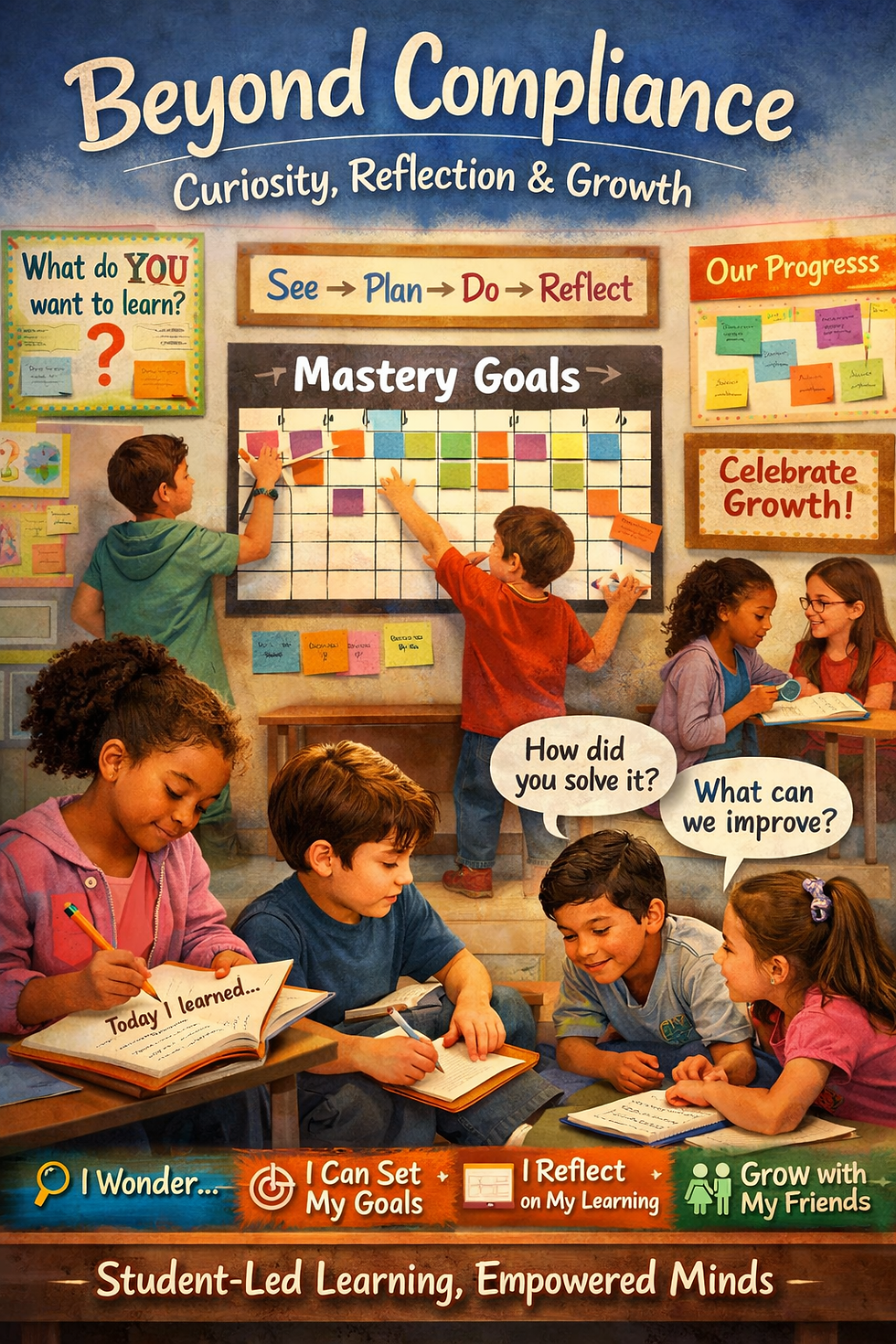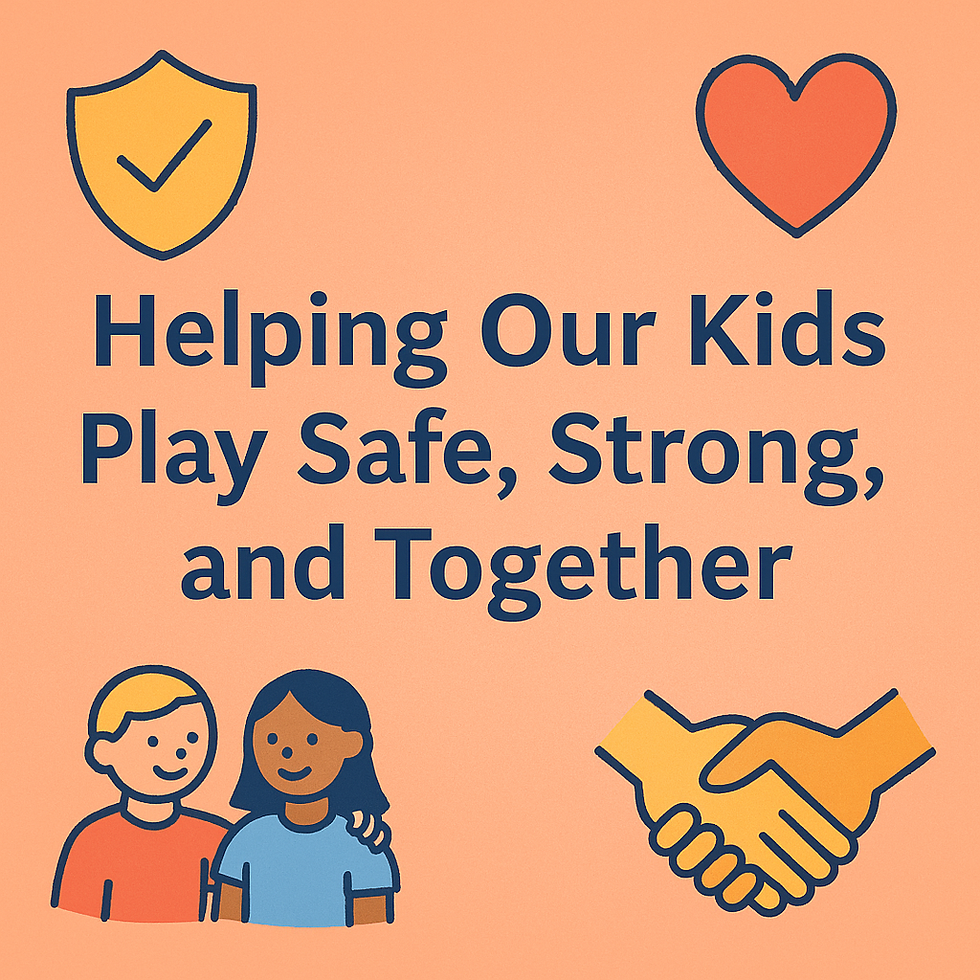From Compliance to Socioemotional Growth: Rethinking Classroom Management
- Greg Mullen

- Mar 27
- 7 min read
The Compliance Trap: Why Rule-Following Isn’t Enough
In many classrooms, "good behavior" is often defined by how well students follow directives. A well-managed class is seen as one where students sit quietly, raise their hands, complete their work on time, and respect the teacher’s authority.
Many teachers cite these kinds of routines and expectations as basic fundamentals of classroom management and often point to successful academic learning as a result. However, while structure and accountability are essential for a healthy learning environment, an overreliance on compliance-based management creates a short-term illusion of success that does not necessarily produce healthy well-balanced adults with reasonably developed emotional self-regulation and social relationship skills.
Consider this scenario:
In Mr. Thompson’s fourth-grade classroom, students are expected to enter the room silently, take out their materials, and begin working. Those who follow the routine earn points toward a class reward. Those who do not receive reminders and, eventually, consequences. The system is predictable, structured, and, on the surface, effective.
But what happens when these same students face an unfamiliar challenge—like conflict with a peer or frustration over a difficult math problem? Without developing competencies such as self-regulation, communication, and problem-solving skills, that reliance on external control from an authority figure may not exist and, as a result, has left students inadequately prepared for real-life challenges.
For some schools and some classrooms, it may be an imperative that “strict” compliance-based management be implemented for the sake of creating a learning space where the teacher is allowed to teach. The problem is not that this isn’t effective, it’s that such an approach, while it does allow academic learning to take place for the brief hours students are in that environment, doesn't develop the skills in those students to thrive in an environment that is not explicitly strict, demanding compliance to avoid external punishment from an authority figure.
Whether you have had to institute a compliance-based management approach or you have inherited socially-progressing students up the grade-level chain who have only experienced a compliance-based management approach, moving beyond that model is going to take a lot of contemplation and planning on the part of leadership and staff.

The Shift: Moving Beyond Compliance to Socioemotional Growth
Recognizing the limitations of a compliance-based model, the challenge becomes clear:
how do we transition from a system that merely enforces behavior to one that cultivates socioemotional competencies?
The answer lies in embedding self-regulation, conflict resolution, and relationship-building into the fabric of daily interactions among teachers and students alike. This includes knowledge of personal development such as simple and compound emotions, support systems for self-efficacy and self-improvement, and incorporating student goal-setting and self-reflection in both academics and socioemotional growth, as well as social development such as the use of empathy versus sympathy, various interpersonal skills, and specific strategies for resolving personal and social conflicts.
Example: Building Emotional Self-Regulation
Instead of enforcing silence upon entering the room, a teacher could create a check-in station where students reflect on their emotions before starting the day. A simple prompt—"How are you feeling today, and what do you need to be successful?"—encourages self-awareness and emotional literacy. This small shift allows students to recognize their emotions, take ownership of their state of mind, and practice self-regulation, rather than relying solely on external enforcement to maintain order.
By integrating emotional self-regulation into classroom routines, teachers can foster in students intrinsic motivation for managing their emotions. When students come to understand the benefits of self-regulation—better focus, fewer conflicts, and improved relationships—they become more invested in developing this skill. Additionally, fostering self-efficacy by helping students set and achieve small emotional-regulation goals builds their confidence in managing their own behavior and supporting others in doing the same.
Example: Conflict Resolution Instead of Punishment
Consider a middle school classroom where two students, Maria and Jordan, get into a significant argument that disrupts the classroom and seems, to the teacher, has gone beyond simply saying sorry and returning their focus to their assigned tasks. In a compliance-based environment, they might be separated, given a warning, or sent to the principal’s office.
In a socioemotionally aware classroom, they are guided through a restorative conversation—where they identify what triggered the conflict, express their feelings, and collaborate on a resolution. Instead of merely punishing negative behavior, this approach helps students develop lifelong conflict-resolution skills and an understanding of accountability beyond just avoiding consequences.
By engaging students in weighing the pros and cons of how they handle conflict, they begin to recognize the personal and social benefits of resolving disputes constructively. Encouraging students to see themselves as individuals who handle conflicts maturely and fairly can also foster an identity in students that aligns with the kind of person they imagine they can be. Lastly, integrating conflict resolution into classroom culture strengthens the sense of community, where students feel responsible for maintaining a positive and respectful environment.
Expanding Beyond the Classroom: School-to-Home Adaptive Discipline Programs
To mitigate maladaptive coping mechanisms and prevent behaviors from escalating into serious challenges, it’s essential to shift from a compliance-based model to one that nurtures socioemotional growth from an early age. While traditional, compliance-driven discipline effectively addresses the symptoms of behavioral issues, it often overlooks underlying emotional or relational needs that may be fueling those behaviors. While these methods might maintain short-term order, they often fail to provide the foundational skills students need to navigate difficult emotions, resolve conflicts, and build positive relationships across grade levels.
By adopting a socioemotional approach to behavior management, schools can intervene proactively to address emotional and social needs before they spiral into disruptive or harmful behaviors. This early focus on self-regulation, emotional awareness, and conflict resolution helps students develop the skills to cope with life’s challenges in healthier ways, reducing the likelihood of maladaptive behaviors later on.
A proactive approach can reduce the need for costly resources and intensive interventions down the line, ensuring that students have the socioemotional skills they need to thrive both inside and outside the classroom. Failure to develop these skills early on can lead to extreme examples of behaviors that require advanced resources and support that a school or district may not be equipped to provide.
Example: Proactive Socioemotional Approach for Elijah
Traditional, Reactive Approach: Elijah has consistently struggled with impulse control, but his behaviors were manageable through traditional discipline methods—warnings, time-outs, and detentions. Over time, however, Elijah’s misbehaviors gradually escalate and become increasingly disruptive. The school responds with more punitive measures—additional detentions and suspensions—but this only deepens Elijah’s frustration and disengagement. The situation worsens, and Elijah’s behaviors reach a point where more intensive resources are needed to achieve earlier levels of desired compliance.
Proactive, Socioemotional Approach: Earlier in his school experience, Elijah had been introduced to strategies that helped him understand his emotions, regulate his impulses, and build healthy relationships with peers. Over the years, he learned how to manage stress, use coping strategies, and resolve conflicts. When his parents decided to separate, his home life became more stressful and Elijah’s misbehaviors in school began to escalate. Recognizing this shift, his teachers were able to access the skills Elijah has already learned and the school intervened proactively:
A family meeting was held to discuss the underlying stress at home and explore ways to support Elijah emotionally.
The school provided parent coaching resources to help ensure that Elijah’s coping skills are reinforced and supported consistently at home as well as at school.
The school’s staff was also equipped to check in weekly with Elijah, helping him apply the stress management strategies he’s learned in class and develop even more advanced coping techniques.
This approach not only addresses the immediate challenges Elijah faces but also draws on the skills he has already developed, reinforcing and building on his existing knowledge to help him navigate his emotions more effectively. Because these strategies already existed as part of the school’s culture of promoting healthy socioemotional competencies in staff and students, the effort required to provide Elijah this extra support was available and accessible.
Example: Proactive Socioemotional Approach for Mia
Traditional, Reactive Approach: Mia frequently disregards classroom expectations, and her behaviors become a source of tension between the teacher and her parents, who often question the teacher’s methods. As her actions escalate, the school responds with increasingly severe punishments and Mia’s parents continue to blame the school for the deterioration of Mia’s behaviors over time.
Proactive, Socioemotional Approach: From an early age, Mia has been introduced to socioemotional learning tools that teach emotional regulation, empathy, and problem-solving. These tools have helped her navigate conflicts and understand how her actions affect others. Over time, she’s developed a growing sense of self-awareness and emotional intelligence, but she has struggled with a lack of consistency in applying these skills at home.
Rather than waiting for her behaviors to escalate, the school intervenes proactively:
A collaborative parent-teacher meeting is held to discuss the concerns regarding Mia’s behavior and to align on consistent behavioral expectations at home and school.
The school offers parent workshops to reinforce positive discipline strategies and build a unified approach to Mia’s emotional growth that align with the parents’ values.
Additionally, Mia is given leadership responsibilities in class, which helps her practice self-regulation and apply the skills she’s learned in a meaningful way.
This approach fosters Mia’s sense of accountability and responsibility, providing her with opportunities to practice positive behaviors while receiving continuous support and guidance.
The Takeaway
It’s understandable that many educators, especially teachers and principals, may feel overwhelmed by the idea of shifting from a traditional compliance-based management approach to a socioemotional model. The constant pressures of managing classrooms, meeting academic expectations, and responding to daily challenges often leave little room for additional initiatives. The thought of introducing new strategies or overhauling existing systems may seem impossible, especially when there’s already so much on your plate.
However, it’s crucial to recognize that the effort to implement socioemotional approaches can actually free up more time and energy in the long run. By shifting away from the traditional compliance-based model—one that focuses primarily on punitive measures and short-term behavior control—you can reduce the need for frequent discipline interruptions, disengaged students, and the repetitive cycle of corrective actions that take away from instructional time.
A socioemotional approach encourages students to build emotional regulation, conflict resolution, and positive relationship skills from an early age. Over time, this leads to less frequent and less severe behavior disruptions because students are better equipped to handle their emotions, interact positively with peers, and engage in self-regulation. Instead of constantly reacting to misbehavior with more consequences, you’ll be setting a foundation for preventing problems before they escalate.
The key to making this shift feasible is understanding that it requires appropriate training and support. It's not an overnight change, and it’s normal to feel ambivalent at the start. But with time, professional development, and collaboration, a socioemotional approach will create the bandwidth necessary to address the emotional and relational needs of your students while still meeting academic goals. As students develop the skills to manage their emotions and behavior independently, you’ll find that discipline becomes less about controlling negative behaviors and more about fostering positive growth.
In essence, shifting toward a socioemotional approach doesn’t add more work—it makes a lot of what you may already be doing more effective. By providing students with the tools they need to thrive emotionally and socially, you’re investing in their long-term success. And, over time, this will reduce the need for frequent interventions, leading to a more positive and efficient learning environment for everyone.
Greg Mullen
March 27, 2025






